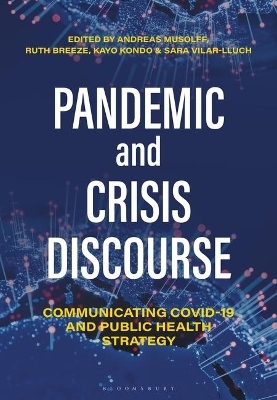
Pandemic and Crisis Discourse
Bloomsbury Academic (Verlag)
978-1-350-23272-3 (ISBN)
Exploring how crisis discourse has become a part of managing the public health crisis itself, this book focuses on the communicative tasks and challenges for both speakers and their public audiences in seven areas:
- establishment of discursive and political authority
- official governmental and expert communication to the public
- public understanding of government communication
- legitimation of public health management as a ‘war’
- judging and blaming a collective other
- cross-national comparison and rivalry
- empathy and encouragement
Covering global discourses from Asia, Europe, the Middle East, North and South America, and New Zealand, chapters use corpus-based data to cast light on these issues from a variety of languages. With crisis discourse already the object of fierce national and international debates about the appropriateness of specific communicative styles, information management and ‘verbal hygiene', Pandemic and Crisis Discourse offers an authoritative intervention from language experts.
Andreas Musolff is Professor of Intercultural Communication at the University of East Anglia, UK. Ruth Breeze is Professor of English at the Institute of Modern Languages at the Universidad de Navarra, Spain. Kayo Kondo is Teaching Associate at the School of East Asian Studies at the University of Sheffield, UK. Sara Vilar-Lluch is a Spanish Language Tutor at the Modern Language Centre, King’s College London, UK.
List of Figures
List of Tables
List of Contributors
Introduction, Andreas Musolff, Ruth Breeze, Kayo Kondo and Sara Vilar-Lluch
Part I: The Discourse of Authority in a Global Crisis: Who Defines (If There Is) a Pandemic?
1. COVID-19 Press Conferences Across Time: World Health Organization vs. Chinese Ministry of Foreign Affairs, Dennis Tay
2. Exploring the Multimodal Representation of COVID-19 on the Official Homepage of World Health Organization (WHO): A Social-Semiotic Approach, Amir H. Y. Salama
3. COVID-19 Representations in Political Statements: A Corpus-Driven Analysis, Alexandra Papamanoli and Themis P. Kaniklidou
4. How Autocrats Cope with the Corona Challenge: Belarus vs. Russia, Daniel Weiss
5. Counting Coronavirus: Mathematical Language in The UK Response to Covid-19, Lee Jarvis
Part II: The Discourse of Crisis Management: How is the Public Meant to and How Does it Understand the Pandemic?
6. “Coronavirus Explainers” for Public Communication of Science: Everything the Public Needs to Know, María José Luzón
7. ‘COVID Warriors: An Analysis of the Use of Metaphors in Children’s Books to Help them Understand Covid-19, María Muelas-Gil
8. Corona in the Linguistic Landscape, Neele Mundt and Frank Polzenhagen
9. Political Comedy and the Challenges of Public Communication during the Covid-19 Crisis: A Corpus-Based Study of Last Week Tonight’s Coverage of the Pandemic, Virginia Zorzi
10. Social Reaction to a New Health Threat: The Perception of the COVID-19 Health Crisis by British and Spanish Readerships, Sara Vilar-Lluch
11. How to Pass this Exam? Dealing with COVID-19 through Metaphors in Turkish Online Public Discourse, Melike Bas and Esranur Efeoglu-Özcan
Part III: The Discourse of ‘War’ against the Pandemic: How to ‘Fight’ COVID-19?
12. When Wars are Good: Emotional Unpacking Anti-Coronavirus Measures, Molly Xie Pan and Joanna Zhuoan Chen
13. Legitimising a Global Fight for a Shared Future: A Critical Metaphor Analysis of the Reportage of COVID-19 in China Daily, Yating Yu
14. Metaphoric Framings of Fighting COVID-19, Mariana Neagu
15. From an Invisible Enemy to a Football Match with the Virus: Adjusting the COVID-19 Pandemic Metaphors to Political Agendas in Serbian Public Discourse, Nadežda Silaški and Tatjana Ðurovic
16. Are Health Care Political Responses Gendered? A Case Study, Fabienne Baider and Maria Constantinou
17. “War against COVID-19”: Is the Pandemic as War Metaphor Helpful or Hurtful?, Andreas Musolff
Part IV: The Discourse of Judgement and Rivalry: Blaming Other/s for the Pandemic and Comparing National Performances
18. “Chinese Virus”: A Multimodal Critical Discourse Analysis of U.S. Government Communication about COVID-19 and its Impact on Chinese and Asian Americans in the U.S., Peiwen Wang and Theresa Catalano
19. ‘Those Lunatic Zombies’: The Discursive Framing of Wuhan Lockdown Escapees in Digital Space, Janet Ho and Emily Chiang
20. Identity as Crime: How Indian Media’s Coverage Demonised Muslims as Coronavirus Spreader, Aaquib Khan
21. Media Discourse in Slovenia and in the Slovenian-Italian Cross-Border Area during the COVID-19 Pandemic, Vesna Mikolic
Part V: The Discourse of Empathy and Encouragement: How to Foster Solidarity among Doctors, Patients and Health Experts
22. Agency in End-of-Life Conversations during the COVID-19 Pandemic, Dariusz Galasinski and Justyna Ziólkowska
23. Doctors’ Empathy and Compassion in Online Health Consultations during the COVID-19 Pandemic in Japan, Kayo Kondo
24. “Masks aren’t Comfortable or Sexy, but…”: Exploring Identity Work on Dr Mike’s Instagram during the First Phase of the COVID-19 Pandemic, Kim Schoofs, Dorien Van De Mieroop, Stephanie Schnurr, Haiyan Huang and Anastasia Stavridou
25. Choosing to Stay Fit? Glocalized Ideologies of Health and Fitness during a Pandemic, Ulrike Vogl, Geert Jacobs, Karin Andersson and Jesper Andreasson
26. Unite against COVID-19: Jacinda Ardern’s Discursive Approach to the Pandemic, Marta Degani
Index
| Erscheinungsdatum | 09.02.2024 |
|---|---|
| Verlagsort | London |
| Sprache | englisch |
| Maße | 169 x 244 mm |
| Themenwelt | Geisteswissenschaften ► Sprach- / Literaturwissenschaft ► Sprachwissenschaft |
| Medizin / Pharmazie ► Medizinische Fachgebiete | |
| ISBN-10 | 1-350-23272-6 / 1350232726 |
| ISBN-13 | 978-1-350-23272-3 / 9781350232723 |
| Zustand | Neuware |
| Informationen gemäß Produktsicherheitsverordnung (GPSR) | |
| Haben Sie eine Frage zum Produkt? |
aus dem Bereich


